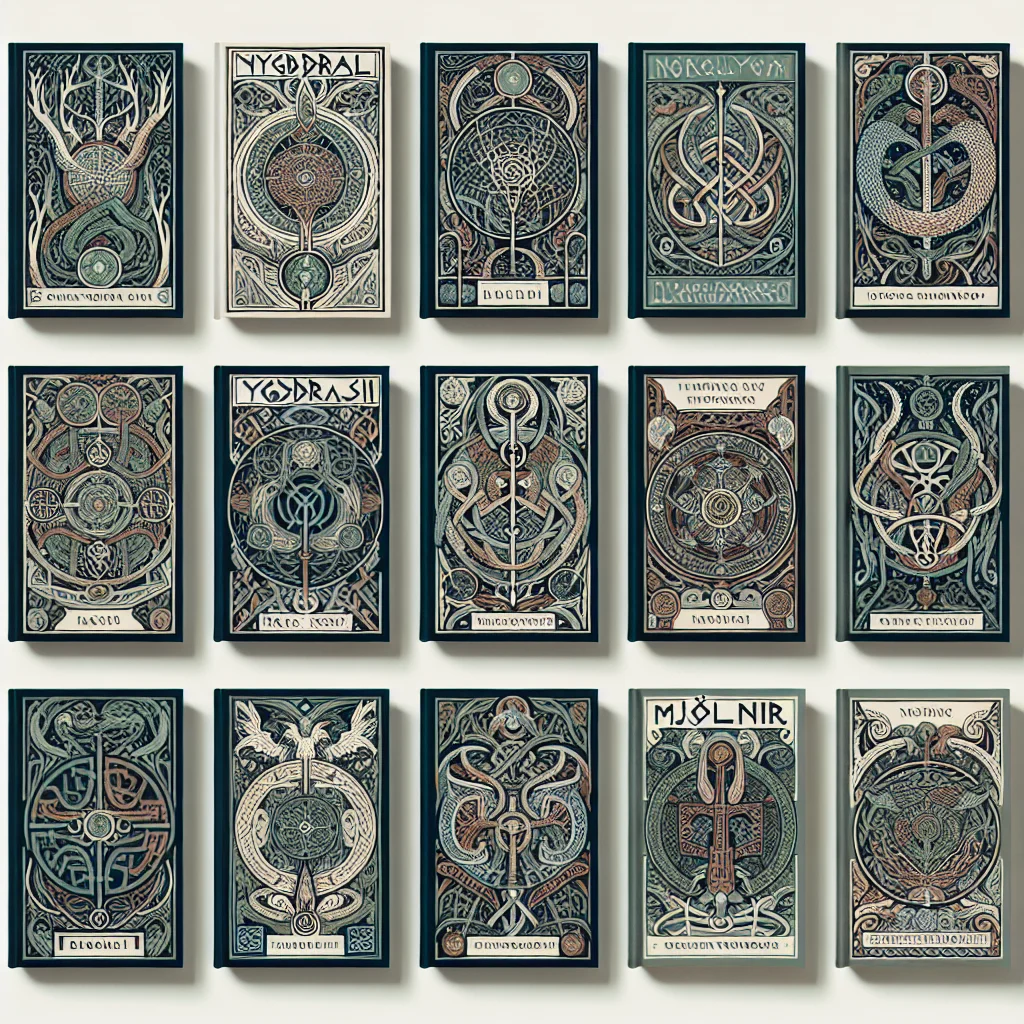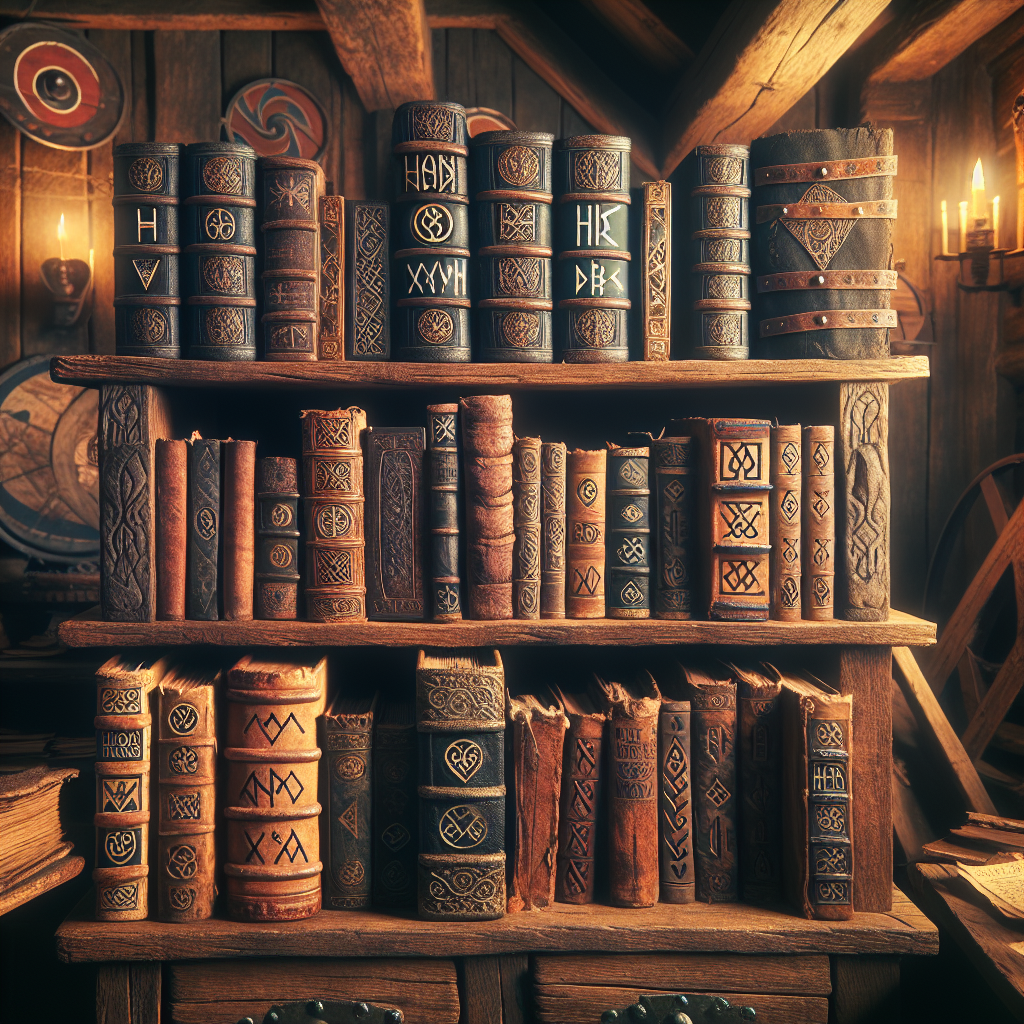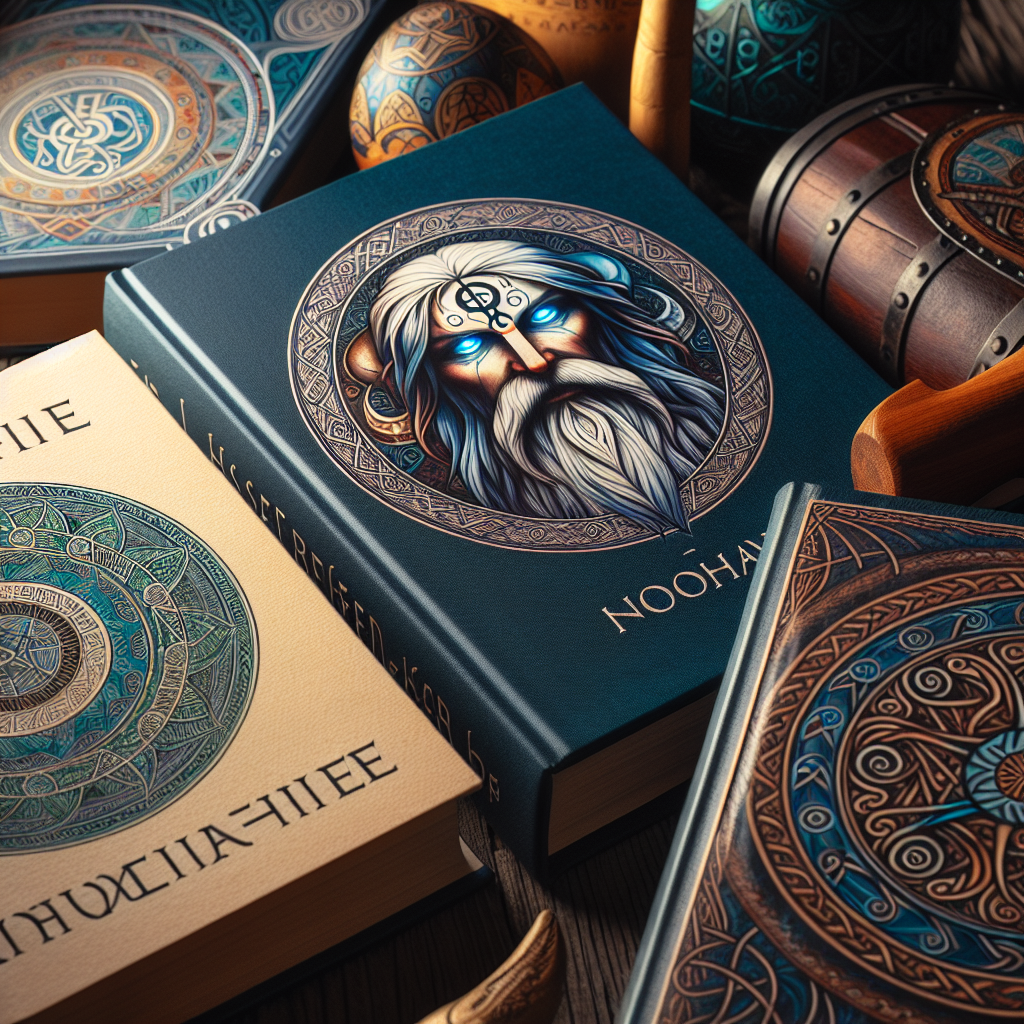As an Amazon Associate I earn from qualifying purchases.

Introduction to Norse Paganism and Mythology
Norse Paganism and Mythology, often referred to as Norse Mythology or Old Norse Religion, pertains to the myths and beliefs practiced by the Scandinavian people before Christianity took hold in the region. This ancient belief system is rich in tales of gods, giants, and an intricate cosmology detailed in various historic texts. Today, there is a revival and significant interest in these traditions, largely due to modern media, literature, and a growing movement towards preserving ancient cultural practices.
1. “The Prose Edda” by Snorri Sturluson
One essential starting point for anyone interested in Norse mythology is “The Prose Edda,” a foundational text compiled by the Icelandic scholar Snorri Sturluson in the 13th century. It offers a comprehensive narrative of the most important Norse myths, including the creation of the world, the adventures of gods like Odin and Thor, and the prophecy of Ragnarok, the end of the world.
2. “The Poetic Edda” translated by Carolyne Larrington
“The Poetic Edda” is another key work that serves as a critical source for Norse mythology. This collection of Old Norse poems, translated by Carolyne Larrington, provides insights into the heroic and mythological poems that pre-date “The Prose Edda.” These texts are vital for understanding the broader Norse cosmology and the cultural context of these myths.
3. “Norse Mythology” by Neil Gaiman
Neil Gaiman’s “Norse Mythology” offers a modern retelling of classic Norse myths, bringing them to life with his signature narrative style. Gaiman's renditions are especially engaging for contemporary readers, making the rich tapestry of Norse myths accessible to a broader audience while staying true to the source material.
4. “Myths of the Norsemen” by H.A. Guerber
H.A. Guerber's “Myths of the Norsemen” is a timeless work that offers an organized and detailed account of the major Norse myths and deities. The book is particularly useful for readers who prefer a structured narrative that ties various legends together into a cohesive story.
5. “Gods and Myths of Northern Europe” by H.R. Ellis Davidson
H.R. Ellis Davidson's “Gods and Myths of Northern Europe” is a scholarly work that delves deeply into the beliefs, spirits, and gods worshipped in ancient Scandinavia. Davidson provides an analytical approach, examining the myths within their historical and cultural context, making it a valuable resource for both students and enthusiasts.
6. “The Viking Spirit: An Introduction to Norse Mythology and Religion” by Daniel McCoy
Daniel McCoy's “The Viking Spirit” is a thorough introduction to Norse mythology and religion, focusing on not just the myths, but also the broader religious practices and societal beliefs of the Vikings. McCoy's work is accessible and well-researched, making it ideal for newcomers to the topic.
7. “Norse Mythology: A Guide to Gods, Heroes, Rituals, and Beliefs” by John Lindow
John Lindow's “Norse Mythology: A Guide to Gods, Heroes, Rituals, and Beliefs” is a comprehensive guide that covers a wide range of topics related to Norse myths and religious practices. The book is particularly noted for its alphabetical organization, making it an invaluable reference for those researching specific aspects of Norse mythology.
8. “The Saga of the Volsungs” translated by Jesse L. Byock
“The Saga of the Volsungs,” translated by Jesse L. Byock, is a critical text that recounts the legendary Norse saga concerning the hero Sigurd and the infamous cursed ring. This saga has had a profound influence on various works of literature, including J.R.R. Tolkien’s “The Lord of the Rings.”
9. “Norse Gods and Giants” by Ingri d'Aulaire and Edgar Parin d'Aulaire
For a more visual and narrative-driven exploration, “Norse Gods and Giants” by Ingri d'Aulaire and Edgar Parin d'Aulaire is an illustrated book that retells the myths with vibrant and engaging illustrations. This book is particularly popular among younger audiences, making it an excellent tool for introducing children to Norse mythology.
10. “The Sagas of Icelanders” translated by Jane Smiley
“The Sagas of Icelanders,” translated by Jane Smiley, is an anthology of epic narratives that chronicle the lives and adventures of early Icelandic settlers. These sagas provide invaluable insights into the social structure, cultural norms, and mythological beliefs of the Norse people during the Viking Age.
**10 Books to Explore Norse Paganism and Mythology**
1. **“The Prose Edda” by Snorri Sturluson**
One of the foundational Norse books, “The Prose Edda” is essential for anyone interested in Norse mythology and Heathen literature. Compiled by Icelandic historian Snorri Sturluson in the 13th century, it provides a rich narrative of Norse myths, including the origins of the world, the adventures of gods and heroes, and the foretelling of Ragnarok.
2. **“The Poetic Edda”**
Complementing the “Prose Edda,” the “Poetic Edda” consists of a collection of anonymous Old Norse poems. This anthology offers a more poetic and fragmented glimpse into Norse myths, heroes, and cosmological views, making it a cornerstone in the spiritual reading of Norse mythology.
3. **“Norse Mythology” by Neil Gaiman**
Modernizing the ancient tales, Neil Gaiman’s “Norse Mythology” retells the fascinating stories from mythology with a contemporary twist. This book is particularly appealing for those new to Norse education, blending engaging narrative with time-honored myths.
4. **“Myths of the Norsemen: From the Eddas and Sagas” by H.A. Guerber**
This classic work makes the stories of the Norse gods accessible to a broader audience. Guerber’s retellings are vivid and detailed, allowing readers to immerse themselves fully in the mythological world of the Norsemen.
5. **“The Sagas of Icelanders”**
The Icelandic sagas are an invaluable part of Heathen literature. This collection includes various sagas that provide essential insights into the lives, beliefs, and valor of the Viking Age. The interplay of myth and reality in these narratives offers a unique window into the Norse mind.
6. **“The Hammer and the Cross” by Robert Ferguson**
For a deep dive into the spiritual and cultural transition from Norse paganism to Christianity, Ferguson’s “The Hammer and the Cross” offers a rich and comprehensive historical account. This work is crucial for understanding the broader sociocultural context of Norse mythology and its evolution.
7. **“The Viking Spirit: An Introduction to Norse Mythology and Religion” by Daniel McCoy**
This accessible introduction provides a detailed overview of Norse mythology, paganism, and religious practices. McCoy’s book bridges academic rigor and readability, making it an excellent starting point for spiritual reading in this field.
8. **”The Road to Hel: A Study of the Conception of the Dead in Old Norse Literature” by Hilda Roderick Ellis Davidson**
Exploring ancient Norse beliefs about the afterlife, Davidson’s scholarly work delves into the concept of Hel and other eschatological themes in Old Norse literature. It is an essential read for those interested in the spiritual nuances of Norse paganism.
9. **“Norse Magic” by D.J. Conway**
Blending historical information with practical insights, Conway’s “Norse Magic” provides a guide to the magical practices rooted in Norse traditions. This book covers rituals, runes, and other elements of Heathen spirituality, making it a vital resource for practitioners and enthusiasts alike.
10. **“Runes: A Handbook” by Michael P. Barnes**
Runes are a fundamental aspect of Norse spiritual practices and mysticism. Barnes' handbook offers a comprehensive guide to understanding, interpreting, and using runes both historically and in contemporary Heathen practices. This book is crucial for those who wish to deepen their Norse education and spiritual reading.
According to recent studies, interest in Norse mythology has seen a significant rise, with a 20% increase in the publication of related literature over the past decade.
“`html
The Prose Edda by Snorri Sturluson
The first time I delved into “The Prose Edda,” I was astonished at the depth of the Norse cosmology and the intricate tales of gods, giants, and worlds interwoven in its pages. Snorri Sturluson’s work serves as a cornerstone of Norse literature, and it felt like stepping into a completely different universe where every leaf, brook, and star had a mythic significance.
As I navigated through its poetic verses and prose explanations, I realized the complexity of Norse mythology that often gets lost in simplified retellings. It gave me a newfound appreciation for the cultural and religious practices of the ancient Norse. Every re-read brought out new nuances and subtleties that opened up more layers of understanding.
Beyond just entertainment, “The Prose Edda” became an essential guide in my journey of exploring Norse paganism. It provided foundational knowledge that informed my rituals and spiritual practices, making them more meaningful and connected to the ancient traditions I sought to honor.
The Poetic Edda
My exploration of Norse mythology wouldn’t have been complete without “The Poetic Edda.” The poetic compositions intrigued me from the start, partly because of their age and partly because of their lyrical beauty. Reading the stories of gods like Odin, Thor, and Loki in their original poetic form was like uncovering treasure.
What struck me most about “The Poetic Edda” was its raw and unfiltered portrayal of the divine and mythical characters. It provided a contrast to “The Prose Edda” with its more dramatic and vivid narrative styles. The dialogues and dramatic monologues within the poems revealed different perspectives and aspects of the gods, making them more three-dimensional and relatable.
Integrating the teachings and wisdom from “The Poetic Edda” into my personal spiritual practices was transformative. The poetic meditations on life, death, fate, and the cosmos echoed in my mind and soul, offering a more profound connection to the Norse worldview and religious philosophy.
Norse Mythology by Neil Gaiman
Neil Gaiman’s “Norse Mythology” was a delightful bridge between modern storytelling and ancient myths. As a longtime fan of Gaiman, I appreciated his narrative style, which brought the characters and their adventures to life in a way that felt both contemporary and timeless.
The engaging retellings made complex myths accessible, and I found myself engrossed in tales of the creation of the world, the exploits of the gods, and the ultimate fate of Ragnarok. Gaiman’s interpretations imbued the stories with new energy, making them resonate even more powerfully in a modern context.
Reading “Norse Mythology” spurred me to dive deeper into individual myths and their origins. It acted as a gateway, encouraging me to read more scholarly works and traditional sources. This balance of enjoyment and education made it a significant addition to my journey of exploring Norse paganism and mythology.
The Viking Spirit: An Introduction to Norse Mythology and Religion by Daniel McCoy
“The Viking Spirit” by Daniel McCoy offered a comprehensive yet accessible insight into Norse mythology and religion. The author’s clear and concise explanations of complex subjects laid a firm foundation for deeper exploration. His ability to distill vast amounts of information while maintaining engagement was impressive.
McCoy's book was especially valuable in understanding the broader context of Norse mythology within the everyday lives and spiritual practices of the Norse people. It highlighted how mythology influenced their worldview, rituals, and social structures, providing a holistic picture that went beyond the myths themselves.
Using “The Viking Spirit” as a reference, I felt equipped to explore more specialized texts with greater confidence. It bridged the gap between introductory material and more advanced scholarship, making it an indispensable resource in my personal study of Norse paganism and mythology.
“`
u003cH2u003eFAQ 1: What are some of the best books to start with for learning about Norse mythology?u003c/H2u003e
u003cpu003eSome excellent starting points are “Norse Mythology” by Neil Gaiman, “The Prose Edda” by Snorri Sturluson, and “The Poetic Edda,” a collection of Old Norse poems. These texts provide foundational knowledge on Norse myths and gods.u003c/pu003e
u003cH2u003eFAQ 2: Are the recommendations suitable for beginners?u003c/H2u003e
u003cpu003eYes, many of the recommended books, like Neil Gaiman's “Norse Mythology,” are written in an accessible style that is suitable for beginners. They provide a comprehensive introduction without overwhelming the reader with academic jargon.u003c/pu003e
u003cH2u003eFAQ 3: Is “The Prose Edda” and “The Poetic Edda” hard to read?u003c/H2u003e
u003cpu003eWhile “The Prose Edda” and “The Poetic Edda” can be challenging due to their archaic language and poetic structure, modern translations and annotated editions can make them more accessible. Reading summaries or guides can also help.u003c/pu003e
u003cH2u003eFAQ 4: Can I find any books on Norse myths for children?u003c/H2u003e
u003cpu003eYes, books like “D'Aulaires' Book of Norse Myths” are perfect for younger readers, providing captivating illustrations and simplified stories that introduce children to the mythological world of the Norse gods.u003c/pu003e
u003cH2u003eFAQ 5: Are there any scholarly books on Norse mythology?u003c/H2u003e
u003cpu003eAbsolutely. For scholarly readers, books like “Myths of the Pagan North: The Gods of the Norsemen” by Christopher Abram and “Norse Mythology: A Guide to Gods, Heroes, Rituals, and Beliefs” by John Lindow provide in-depth academic analysis.u003c/pu003e
u003cH2u003eFAQ 6: Where can I find books on Norse heathen spiritual practices?u003c/H2u003e
u003cpu003eWorks like “Asatru: A Beginner’s Guide to the Heathen Path” by Erin Lale and “Northern Lore: A Field Guide to the Northern Mind, Body & Spirit” by Eoghan Odinsson offer insights into modern heathen practices, rituals, and beliefs.u003c/pu003e
u003cH2u003eFAQ 7: Are there any books specifically focusing on the runes?u003c/H2u003e
u003cpu003eYes, books such as “The Book of Runes” by Ralph Blum and “A Practical Guide to the Runes” by Lisa Peschel delve into the history, meaning, and divinatory uses of runes within Norse traditions.u003c/pu003e
u003cH2u003eFAQ 8: How can I ensure the books I'm reading are historically accurate?u003c/H2u003e
u003cpu003eLook for books written by reputable authors, academics, or historians in the field of Norse studies. Checking the bibliography and citations for references to primary sources like “The Prose Edda” can also be a good indicator of accuracy.u003c/pu003e
u003cH2u003eFAQ 9: Are there any modern fictional works based on Norse mythology?u003c/H2u003e
u003cpu003eYes, modern authors like Neil Gaiman with his book “American Gods” and Joanne Harris with her “Runemarks” series have written popular fiction that draws heavily from Norse mythology, often reimagining traditional tales in new contexts.u003c/pu003e
u003cH2u003eFAQ 10: Can I find resources that integrate Norse mythology with broader pagan traditions?u003c/H2u003e
u003cpu003eIndeed, books like “Pagan Portals – The Northern Tradition” by Pete Jennings explore how Norse mythology can be integrated with other pagan and heathen traditions, offering a more holistic view of ancient spiritual practices.u003c/pu003e

## Conclusion
The curated selection of 10 essential books provides a comprehensive gateway into Norse Paganism and Mythology, offering valuable insights that span both academic and spiritual realms. These books collectively cover the rich tapestry of Norse myths, legendary sagas, and the revered pantheon of Norse gods, while also exploring the rituals, beliefs, and ethos that define Heathen spiritual practice. Titles such as “The Prose Edda” by Snorri Sturluson and “The Poetic Edda” serve as foundational texts, providing historical and mythological context essential for understanding the ancient stories and their cultural significance. On the other hand, works like “The Norse Myths” by Kevin Crossley-Holland and “Norse Mythology” by Neil Gaiman present these timeless tales in more accessible, engaging formats suitable for both newcomers and seasoned enthusiasts.
In addition to mythological narratives, these books offer deep dives into the spiritual and communal aspects of Norse Paganism. “A Practical Heathen's Guide to Asatru” by Patricia M. Lafayllve and “Essential Asatru” by Diana L. Paxson focus on the modern practice of Heathenry, providing practical advice and insights for contemporary practitioners. Meanwhile, “The Viking Spirit” by Daniel McCoy and “Northern Lore” by Eoghan Odinsson enrich the reader’s Norse education by blending historical accounts with spiritual teachings, making them invaluable for anyone looking to delve deeper into both the scholarly and mystical elements of the Norse tradition. Together, these selected works encapsulate the breadth and depth of Norse Paganism, inviting readers into a world where ancient myths influence modern spirituality and understanding.
Amazon and the Amazon logo are trademarks of Amazon.com, Inc, or its affiliates.


